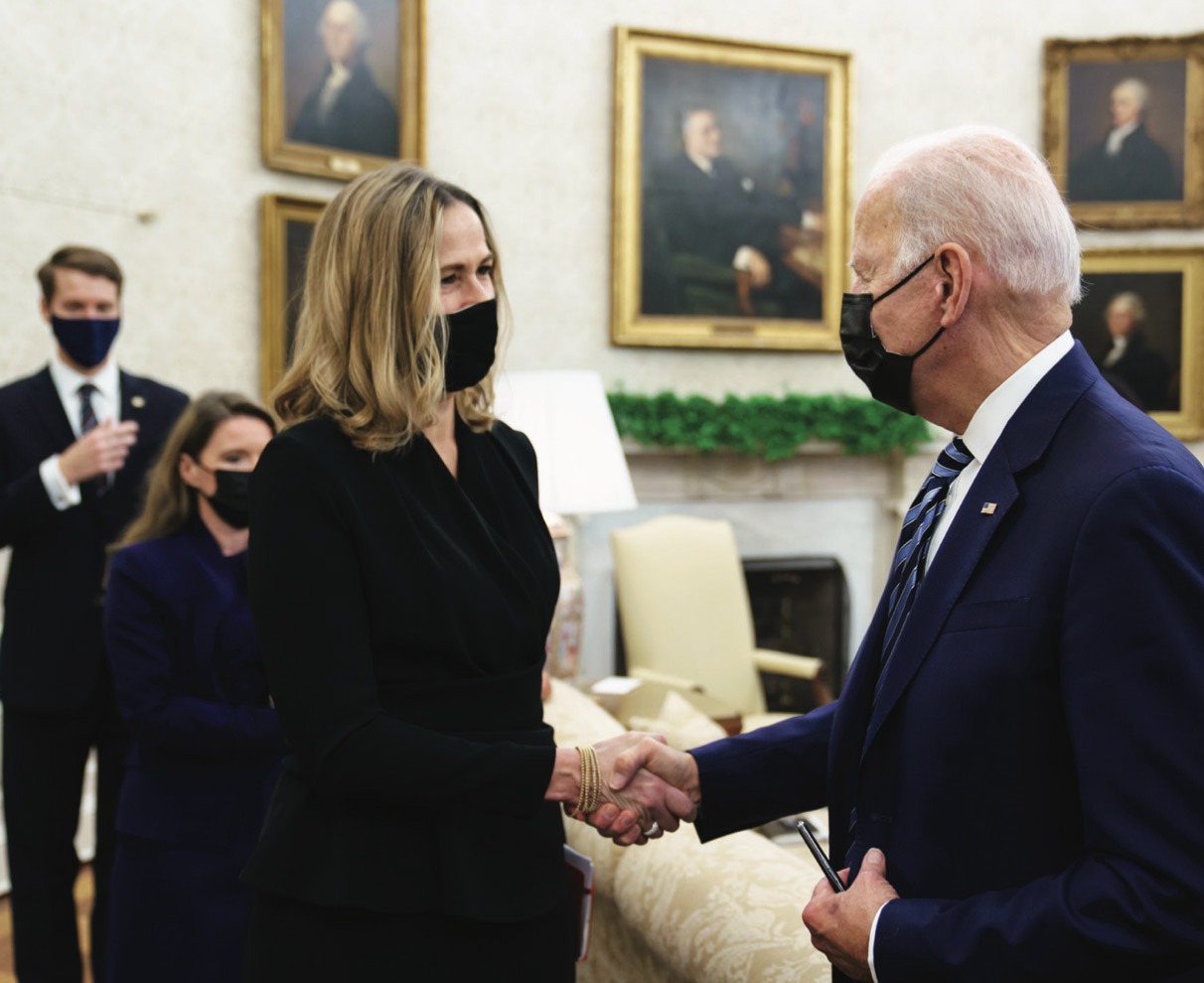The View from 501 Pennsylvania Avenue: Common Interests, Shared Values and Trade

Kirsten Hillman was appointed Canada’s ambassador to the United States in 2020, the first woman to fill the Washington role that is the jewel in the crown of Canada’s diplomatic service. Hillman’s background as Canada’s most senior trade negotiator and as Canada’s senior legal adviser to the World Trade Organization were indispensable assets to the negotiation of the Canada-United States-Mexico Agreement. Ambassador Hillman describes how that and other recent bilateral engagements have served Canada’s relationship with our closest ally.
Kirsten Hillman
There is no question that North American economic integration, starting with the Canada-US Free Trade Agreement in 1989 and followed by the North American Free Trade Agreement (NAFTA) five years later, strengthened the economies of Canada, the United States and Mexico and made them more innovative and competitive.
However, NAFTA and other free trade agreements have also been lightning rods for criticism and concerns over the domestic effects of economic globalization. As a consequence, for most of my career as a trade lawyer and trade negotiator, the accepted wisdom was that NAFTA was too politically sensitive to be modernized. While there were certainly aspects of the agreement that were due for a refresh, and new issues to be included, the political debate surrounding the agreement, especially in the US, made such a move too risky. The negotiation would inevitably lead to sensitive demands and counterdemands, and whatever the outcome, there would be no way to strike a new deal that would satisfy the critics.
Nevertheless, shortly after President Donald Trump was sworn into office, he moved forward with his promise to renegotiate what he called “the worst trade deal in history”. The NAFTA renegotiation that followed differed from any other in which I have participated.
Normally, before countries start a trade negotiation, they spend months in exploratory discussions to identify key objectives and any “no-go” zones. Consequently, if they decide to proceed, they come to the table with common goals, all expecting to get benefits from the deal. Trade agreements are not simply economic arrangements; they are geopolitical choices, to deepen relationships to the mutual benefit of all parties.
In the NAFTA renegotiation, Canada and Mexico were brought to the table by the threat that President Trump would withdraw the US from the agreement. In addition, the stated goal of the president was not to modernize the agreement to bring mutual benefit to all parties, but to “recalibrate” it by pushing Mexico and Canada to make concessions while offering none in return, other than simply staying in the deal.
Canada’s top-notch negotiators responded quickly to these unexpected challenges. The political leadership from Prime Minister Justin Trudeau was clear, and then-Foreign Affairs Minister Chrystia Freeland, who led the discussions, was resolute. Maintaining a strong, open and predictable trading relationship with the US was essential to Canada, but we knew that it was also very important to the US. This fact, combined with the unusual dynamics in these talks led to a new aspect to trade negotiations for Canada: widespread and highly coordinated advocacy in the United States.

Typically, governments spend time communicating the benefits of a trade agreement domestically. In this case, we also needed to reach out to US decision-makers from both political parties at the federal and state levels, as well as US businesses and unions, to promote the benefits of keeping NAFTA and to convey the damage that a US withdrawal would cause.
Working in coordination with the Prime Minister’s Office, the Privy Council Office and Global Affairs, our US Embassy and 12 consulates across the country gathered intelligence and developed a detailed, systematic and multi-pronged plan. The goal was to demonstrate to key US interlocutors that predictable, rules-based trade with Canada is in the interests of Americans; and that “ripping up NAFTA” was not. We identified Canadian voices that would resonate with US decision makers and we targeted sectors, businesses, community leaders and other influential individuals across the US, especially those states and sectors that rely on trade with Canada.
One of our greatest strengths is the depth and breadth of relationships that Canadians have with Americans. We mobilized as many of these as possible. We shared tailored data so that the Canadians could provide concrete examples to their specific US counterparts of why NAFTA mattered to them. Coordinated messages were carried by the prime minister and federal ministers, premiers, mayors, business leaders, labour leaders, opposition parties, former political leaders, and of course, all of our diplomats in the US. Overall, the goal was to diminish, and if possible neutralize, the threat of withdrawal and to make it clear that the only deal possible was one that would work for all three countries.
While the negotiations were proceeding, the Trump administration added another challenge by imposing national security tariffs on Canadian steel and aluminum imports, the US’s largest source of these products. Tariffs based on Canada allegedly posing a national security threat called for swift, strong action, and we immediately launched WTO and NAFTA disputes and announced reciprocal, dollar-for-dollar countermeasures valued at $16.6 billion.
Canada’s retaliatory duties were targeted for maximum impact and pressure. We continued our Team Canada advocacy approach, drawing maximum attention to the impact of countermeasures on US communities and companies, particularly those in non-steel-producing areas. We worked to activate as many US voices as possible calling for the removal of the tariffs.
Eventually, the impact of countermeasures became an obstacle to passing the newly negotiated Canada-US-Mexico Agreement (CUSMA) through Congress. Pressure from US states and businesses impacted by the countermeasures was a key factor in their removal from Canadian and Mexican steel and aluminum in May 2019, paving the way for Congressional approval of CUSMA.
While President Trump had specific objectives for the NAFTA renegotiation, the Democrat-controlled Congress had its own. Many of the modifications made by Congress in the areas of labour, environment and dispute settlement built on specific proposals that Canada had made during the negotiations. In the end, when CUSMA passed Congress, it enjoyed significant bipartisan support. It entered into force on July 1, 2020 and preserved market access, improved dispute settlement and added strong, enforceable labour and environment rules and other forward-looking provisions.
President Joe Biden entered the White House in 2021 with a pledge to work with allies and a commitment to the international rules-based order. He and Prime Minister Trudeau moved quickly to release the ambitious Roadmap for a Renewed US-Canada Partnership a month after the president’s inauguration. The roadmap establishes more than two dozen concrete economic, social, environmental and security objectives for bilateral collaboration in the coming years.
An important area of focus is cooperation on supply chains, including the creation of a bilateral Supply Chain Working Group. The first progress report of this group was released in June 2022, highlighting work in eight key sectors, including electric vehicles and batteries, critical minerals, public health, and defense. This is very timely as both Canada and the US are increasingly emphasizing the need to work with allies and the importance of “friend-shoring” critical supply chains.
Despite this strong collaborative approach, Canada must remain vigilant. Given our high degree of integration, US domestic policies and actions can have unintended negative impacts on Canada. The important contacts and valuable experience that we gained during the CUSMA negotiations remain essential today, as we advocate with the Biden administration and Congress.
For example, in the summer of 2021, the Embassy became aware of a proposal in Congress for tax credits for electric vehicles that would only apply to those assembled in the US. If adopted, these tax credits would have been disastrous to our integrated auto industry, put hundreds of thousands of jobs at risk in Canada and the US and jeopardized our shared clean energy goals.
Once again, Team Canada got to work on advocacy. With leadership from the prime minister, who expressed very serious concerns to the president and the Congressional leadership, a multi-faceted advocacy campaign was undertaken. We focused on the potential economic and jobs losses for Americans but also on the risks for our shared energy security, environmental protection goals and critical minerals development. This messaging resonated as the legislation evolved and is reflected in the Inflation Reduction Act signed into law by the president on August 16th.
The challenges of the last few years, including the COVID pandemic, trucker blockades, and supply chain issues, have only served to underscore – and strengthen – the cooperation among governments, businesses and workers in Canada and the US. More recently, with Russia’s invasion of Ukraine, we have demonstrated our joint resolve to stand on the world stage shoulder to shoulder.
I expect more tumultuous times ahead. Putin’s war in Ukraine is jeopardizing food and energy security and critical supply chains, putting the world’s most vulnerable at risk. On China, we share common interests with the US in advancing a level playing field for our workers and businesses. As we advance our common interests and shared values amid the challenges ahead, Canada’s strength in natural resources — energy, critical minerals, food — our skilled and competitive workforce, together with our commitment to environmental protection, labour rights and inclusive trade, will continue to create opportunities for North America. I am confident that with CUSMA as a strong anchor, Canada and the US will continue in a strengthened partnership to advance our shared priorities for the future prosperity of our continent and beyond.
Kirsten Hillman was appointed Canada’s Ambassador to the United States in Washington D.C. in March 2020, the first woman to serve in this position. Prior to this, she served as Deputy Ambassador and Acting Ambassador, and was deeply involved in the negotiations to modernize the NAFTA.
